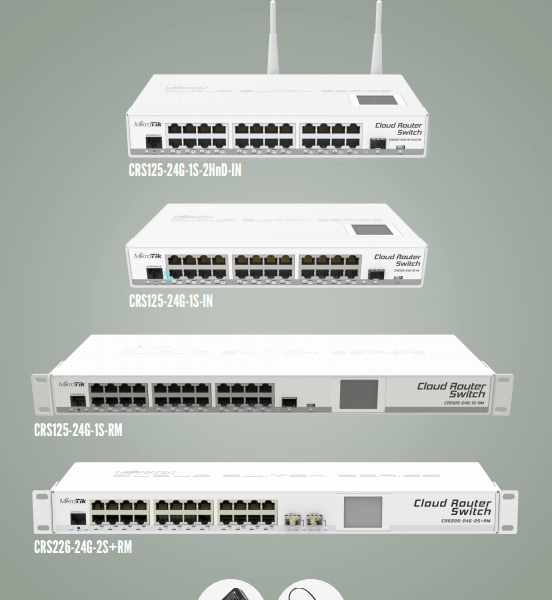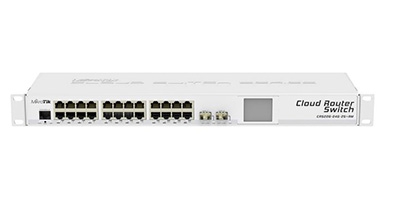Cloud Core Switch—An Economic Choice for L3 Switch
MikroTik Switches have been popularly received favorable reviews, and this is inseparable with their keeping on the bleeding edge of switching technology. As a new member of MikroTik Smart Switch series, cloud core switch, also called cloud router switch, combing the best features of a fully functional router and a Layer 3 switch. That is to say, this cloud router switch works as both switch and router to connect the VLAN. This article would mainly discuss about cloud core switch, CRS226-24G-2S+RM switch and its connectivity solutions, as well as the reasons why they are economic choice for L3 switch.
The cloud core switch, or cloud router switch, abbreviated as CRS, is a highly configurable switch, powered by RouterOS. It has 24 Gigabit Ethernet port. The Ethernet port 2-24 are switched, and the device can be accessed via these ports through the IP 192.168.88.1. Ethernet port 1 is configured as a DHCP client and has firewall on it. The SFP port is configured the same way as Ethernet 1, with a firewall and DHCP client on it. For the cloud router switch, there are nine models currently available. Here lists three different cases of the cloud core switch:
- CRS125-24G-1S-2HnD-IN (integrated wireless, indoor case)
- CRS125-24G-1S-IN (indoor case)
- CRS125-24G-1S-RM (rackmount case)

Figure1: MikroTik cloud router switches
As one of the cloud core switches, CRS226-24G-2S+RM have been highly favored by most people. CRS226-24G-2S+RM is a fully functional layer 3 cloud router switch powered by Router OS, which is also available in 1U rackmount case. It comes with a special switch menu which includes all the specific configuration options for switches. It has 24 Gigabit ports and two SFP+ cages for 10G connectivity in which first SFP port supports 1.25G/10G modules and second port only 10G modules. Ports can be removed from the switch configuration and used for routing purposes if needed. The most distinctive feature of CRS226-24G-2S+RM is that uses a new class of switch chips, which allows us to have two SFP+ ports for 10G connectivity. The main features of this cloud core switch are listed in the following:
- Fully manageable L3 switch, full wire speed switching
- Configure ports as switch, or for routing
- If required, full RouterOS power right there
- SFP+ ports for 10G connectivity

Figure2: cloud core switch CRS226-24G-2S+RM
As being mentioned, the cloud core switch CRS226-24G-2S+RM has 24 Gigabit ports and 2 SFP+ ports. For the twenty-four 10/100/1000 Ethernet ports, you could use both network cables and optical transceivers to connect. The transmission speed of Cat5 and Cat5e cables can be up to 100 Mb/s and 1G respectively. Besides, you can also use 10/100/1000BASE-T copper transceiver to make network connectivity. But it costs more than the network cables. In terms of 10G SFP+ ports, there are also two connectivity approaches. You can use both 10G SFP+ modules and 10G SFP+ DAC copper cable to connect. Relatively speaking, the 10G DAC cable is cheaper a lot than the 10G transceiver. But if transmission quality is your pursuit, and then 10GBASE SFP+ transceivers would be a good choice.
According to the above description, cloud core switches are powered by Router OS. RouterOS lets you add upper layer functionality. The cloud core switch is very far below wire speed when doing layer 3 or above. In fact, the cloud core switch is more of a bare-bones layer 2 switch that has an embedded low-horsepower router. In short, the switch features are useful for making bridges that work at wire speed, but they're limited to simple forwarding and vlan handling. The bridge feature lets you glue almost anything together, and gives lots of filtering/manipulation tools, but it cannot perform at wire speed because it uses the main CPU. Last but not least, the average prices of Mikro Tik cloud core switches are not more than $150, you can check them by this link.
Cloud core/router Switch is a managed switch that runs RouterOS and SwitchOS, which delivers a high performance as a Layer 3 switch. They allow to manage port-to-port forwarding, apply MAC filter, configure VLANs, mirror traffic, apply bandwidth limitation and even adjust some MAC and IP header fields. The economic L3 switch including several switch models covering wide range applications, like enterprise network and home network.